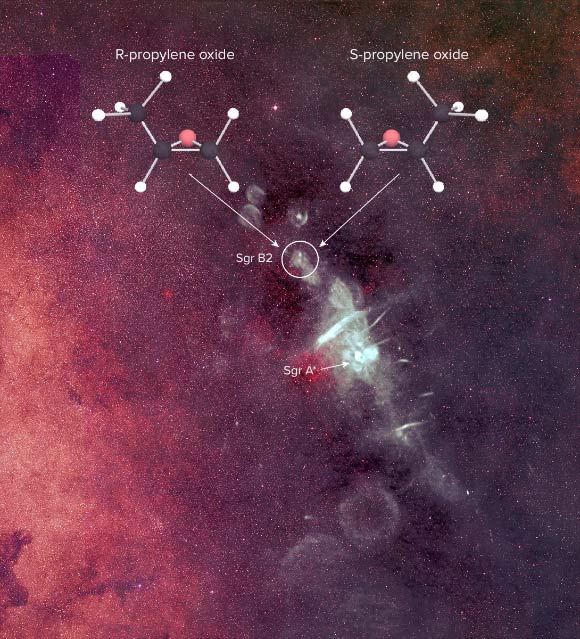Astronomers using highly sensitive radio telescopes have detected, for the first time, a chiral molecule in interstellar space.

Astronomers applaud the first detection of a chiral molecule, propylene oxide, in interstellar space. On Earth, propylene oxide is a common compound used in making polyurethane plastics. Image credit: B. Saxton / NRAO / AUI / NSF / N.E. Kassim, Naval Research Laboratory / Sloan Digital Sky Survey.
Like a pair of human hands, many molecules can exist in forms that are mirror images of each other.
But molecules associated with life, such as amino acids, proteins, enzymes and sugars, are found in nature in only one form.
For example, the amino acids that make up proteins only exist in the left-handed form, while the sugars found in DNA are exclusively right-handed. This phenomenon is known as homochirality.
Chiral molecules have intriguingly been found in meteorites on Earth and Solar System’s comets. None, however, has been detected in space, until now.
A team of astronomers led by Dr. Brett McGuire from the National Radio Astronomy Observatory and Brandon Carroll from the California Institute of Technology has discovered the first interstellar chiral molecule — propylene oxide (CH3CHCH2O).
The molecule was found in the gas phase in a cold, extended molecular shell around protostellar clusters in Sagittarius B2, an enormous star-forming cloud roughly 3 million times the mass of the Sun and located in the center of our Milky Way Galaxy.
“This is the first molecule detected in interstellar space that has the property of chirality, making it a pioneering leap forward in our understanding of how prebiotic molecules are made in the Universe and the effects they may have on the origins of life,” Dr. McGuire said.
“Propylene oxide is among the most complex and structurally intricate molecules detected so far in space,” Carroll added.
“Detecting this molecule opens the door for further experiments determining how and where molecular handedness emerges and why one form may be slightly more abundant than the other.”
According to the astronomers, complex molecules form in interstellar clouds like Sagittarius B2 in several ways.
The most basic pathway is through gas-phase chemistry, in which particles collide and merge to produce ever more complex molecules.
Once organic compounds as large as methanol are produced, however, this process becomes much less efficient.
To form more complex molecules, like propylene oxide, the scientists believe thin mantles of ice on dust grains help link small molecules into longer and larger structures. These molecules can then evaporate from the surface of the grains and further react in the gas of the surrounding cloud.
The research was undertaken primarily with NSF’s Green Bank Telescope in West Virginia. Additional supporting observations were taken with the Parkes radio telescope in Australia.
A paper about the work appears in the June 17 issue of the journal Science.
_____
Brett A. McGuire et al. Discovery of the interstellar chiral molecule propylene oxide (CH3CHCH2O). Science, published online June 14, 2016; doi: 10.1126/science.aae0328







